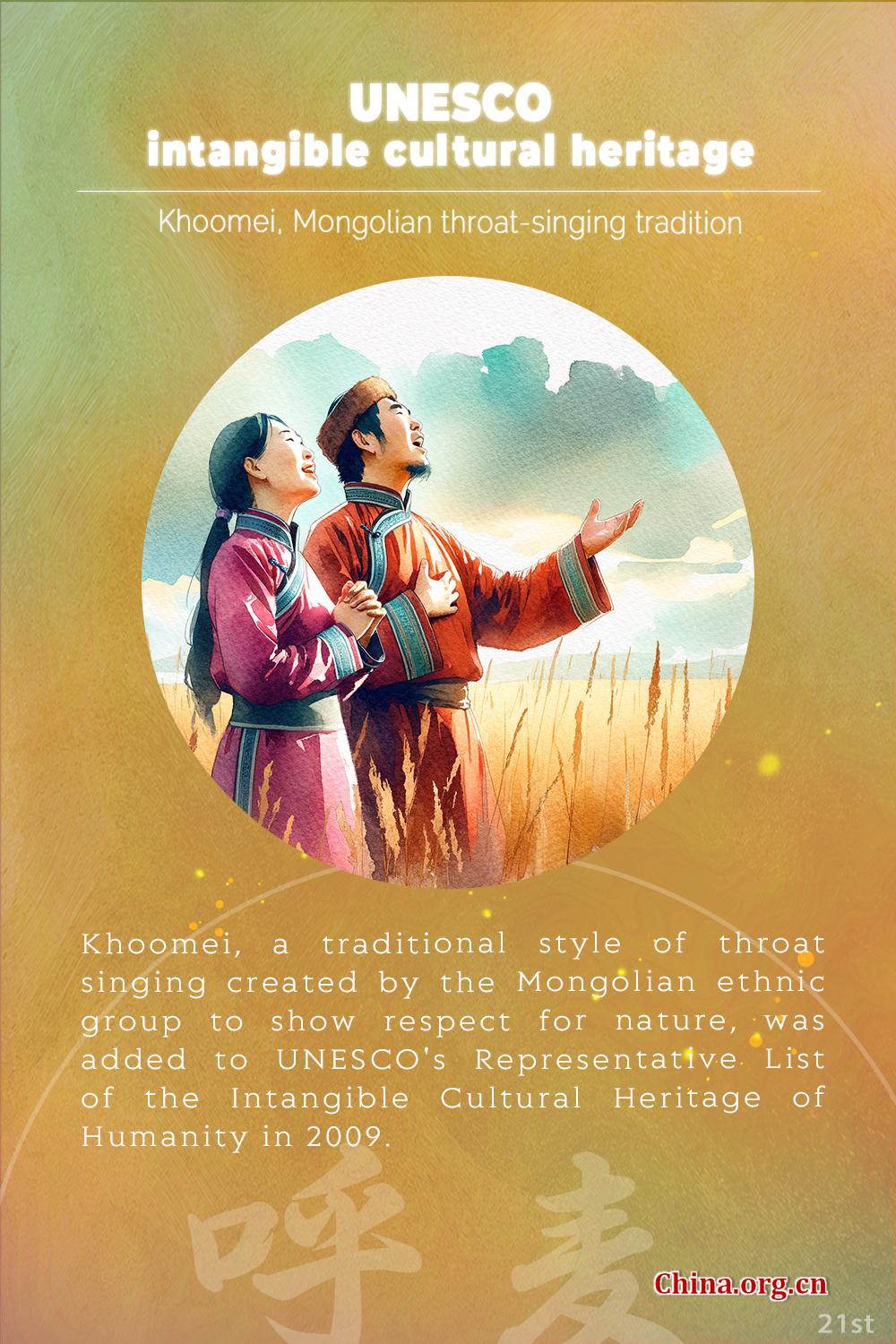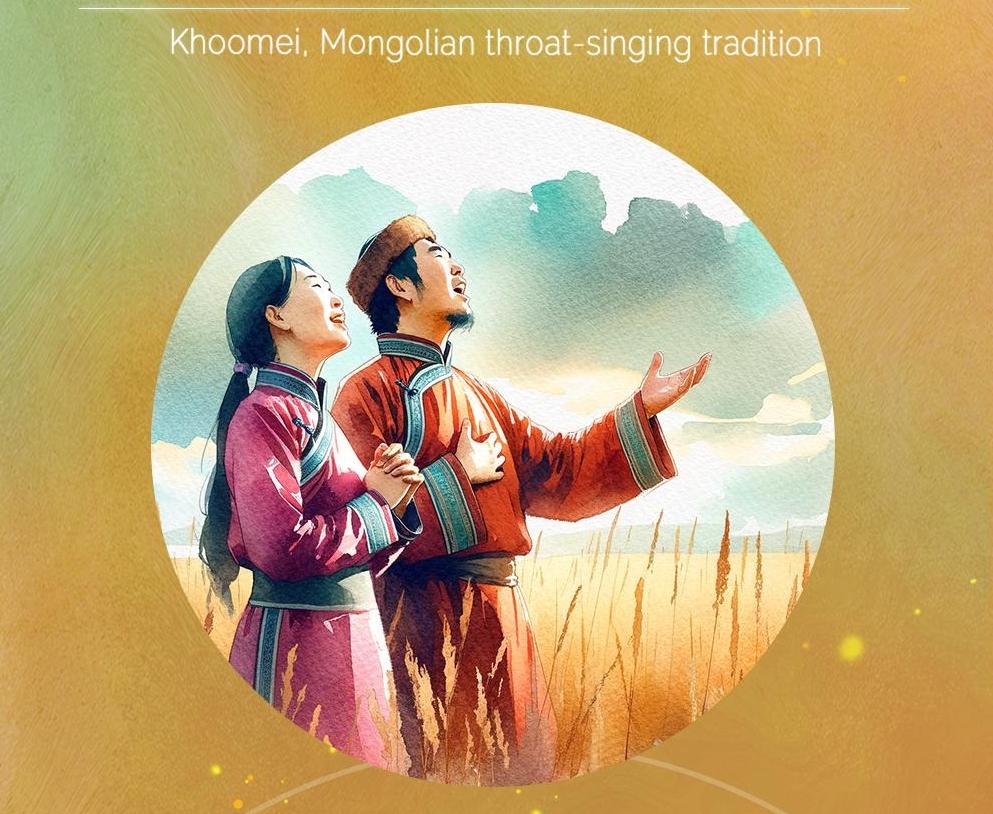
 0 Comment(s)
0 Comment(s) Print
Print E-mail China.org.cn, April 26, 2024
E-mail China.org.cn, April 26, 2024Editor's note: Khoomei, a traditional style of throat singing created by the Mongolian ethnic group to show respect for nature, was added to UNESCO's Representative List of the Intangible Cultural Heritage of Humanity in 2009.

Khoomei, which means throat or larynx in Mongolian, is an ancient style of singing created by the Mongolian ethnic group. They perform this unique form of throat singing as a way to pay homage to nature, their ancestors, and heroes, while also expressing their deep connection to the nomadic way of life.
A single Khoomei singer can produce two or three voices simultaneously in a harmonious manner. Listeners can hear a sustained fundamental bass produced in the singer's throat, usually in the low-mid to mid-range of the performer's normal voice, along with one or two higher tones above the bass. As a result, two or three harmonics can be heard at the same time, spanning one to even six octaves.
This unique performing art requires special singing techniques. Khoomei singers need to relax their abdomen and control pitches through a combination of movements involving the lips, throat, tongue, and jaw. A professional singer can deliver sounds that resemble the wind swirling among rocks, rivers running through valleys, or birds chirping in the forest. Ancient Mongolian tribes believed that singing Khoomei could connect them with nature and the universe.
While UNESCO documents indicate that Khoomei emerged around the 13th century, some online sources trace its origins back to the 3rd century B.C., when the Xiongnu people – an alliance of nomadic tribes also known as the Huns – arose and later settled on the Mongolian Plateau.
Today, Khoomei remains widely practiced among the Mongolian ethnic group, with singers performing both solos and group arrangements. During important festivals such as Naadam, a major celebration for the Mongolian ethnic group, and Tsagaan Sar, also known as the Mongolian Lunar New Year, renowned or professional Khoomei singers perform the style amid a variety of cultural and sports activities. These include candlelighting ceremonies, sacrificial rituals, horse races, archery competitions, wrestling tournaments, and large banquets. The timing and order of the songs are often strictly arranged.
With the Mongolian ethnic group dispersed across borders, the tradition of Khoomei has been preserved in various countries and regions. Today, it is primarily practiced in China's Inner Mongolia Autonomous Region and the Altai mountainous areas of the Xinjiang Uygur Autonomous Region, as well as certain parts of western Mongolia and Russia's Tuva Republic.
Deeply intertwined with the history and culture of the Mongolian ethnic group, Khoomei holds significant importance for studies in anthropology, ethnic history, and folk customs. Recognizing its value, China included Khoomei in its first batch of national intangible cultural heritage in 2006, and in 2009, UNESCO added it to the Representative List of the Intangible Cultural Heritage of Humanity.
UNESCO stated: "Khoomei has long been regarded as a central element representing Mongolian culture and remains a strong symbol of national or ethnic identity. As a window into the philosophy and aesthetic values of the Mongol people, it has served as a kind of cultural emissary promoting understanding and friendship among China, Mongolia, and Russia, and has attracted attention around the world as a unique form of musical expression."
In recent years, Khoomei has gained broader popularity in the global music arena by integrating modern and international elements. It has even become popular at music festivals and on social media platforms, arousing great interest from experts and scholars in fields such as sociology, anthropology, history, cultural studies, music, and art.
In 2020, a short documentary film titled "Amazing Music from Nature" was unveiled at the Asian Pop-Up Cinema, a semi-annual Asian film festival in Chicago, United States. The film showcased Khoomei performed by young multi-ethnic musicians, combining the traditional art form with modern elements, receiving widespread attention. In 2022, pop singer-songwriter Shang Wenjie collaborated with a Khoomei artist for a performance at the Spring Festival Web Gala, one of the most significant celebrations for Chinese people to mark the Lunar New Year. This year, more musicians, including the young composer Xue Tingzhe, are preparing to visit the grasslands of Inner Mongolia to record additional Mongolian folk music, including Khoomei.
Discover more treasures from China on UNESCO's ICH list:
? 2022: Traditional tea processing
? 2020: Wangchuan ceremony, taijiquan
? 2018: Lum medicinal bathing of Sowa Rigpa
? 2016: Twenty-four solar terms
? 2013: Abacus-based Zhusuan
? 2012: Training plan for Fujian puppetry performers
? 2011: Shadow puppetry, Yimakan storytelling
? 2010: Peking opera, acupuncture and moxibustion, wooden movable-type printing, watertight-bulkhead technology of Chinese junks, Meshrep
? 2009: Yueju opera, Xi'an wind and percussion ensemble, traditional handicrafts of making Xuan paper, traditional firing techniques of Longquan celadon, Tibetan opera, sericulture and silk craftsmanship, Regong arts, Nanyin, Khoomei
